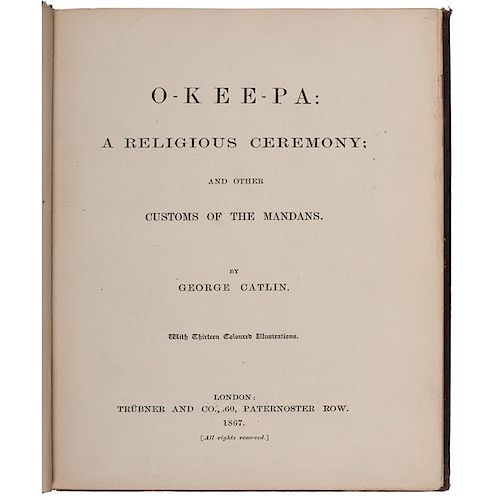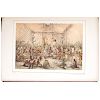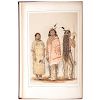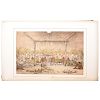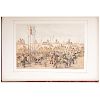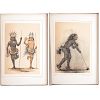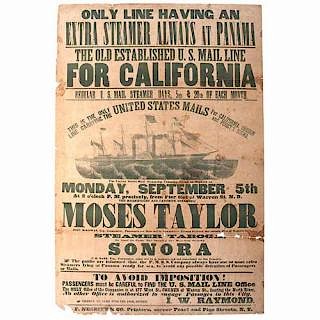George Catlin, O-Kee-Pa: A Religious Ceremony: and Other Customs of the Mandans, 1867
About Seller
6270 Este Ave.
Cincinnati , OH 45232
United States
With offices in Cincinnati, Cleveland and Denver, Cowan’s holds over 40 auctions each year, with annual sales exceeding $16M. We reach buyers around the globe, and take pride in our reputation for integrity, customer service and great results. A full-service house, Cowan’s Auctions specializes in Am...Read more
Two ways to bid:
- Leave a max absentee bid and the platform will bid on your behalf up to your maximum bid during the live auction.
- Bid live during the auction and your bids will be submitted real-time to the auctioneer.
Bid Increments
| Price | Bid Increment |
|---|---|
| $0 | $25 |
| $500 | $50 |
| $1,000 | $100 |
| $2,000 | $250 |
| $5,000 | $500 |
| $10,000 | $1,000 |
| $20,000 | $2,500 |
| $50,000 | $5,000 |
| $100,000 | $10,000 |
About Auction
Jun 10, 2016 - Jun 11, 2016
Cowan's Auctions dawnie@cowans.com
- Lot Description
George Catlin, O-Kee-Pa: A Religious Ceremony: and Other Customs of the Mandans, 1867
Catlin, George. O-Kee-Pa: A Religious Ceremony; and other Customs of the Mandans. With Thirteen Coloured Illustrations. London: Truebner and Co., 1867. First ed. 4to, publisher's maroon cloth with beveled edges, blind-ruled front and back; front with double gilt-fillet panel with gilt floral corners, gilt lettering; all edges gilt; collation: vi, [ii], 52, iii [Folium Reservatum bound in], [1 blank], thirteen chromolithographed plates after Catlin's paintings by Simoneau & Toovey, all with tissue guards. Also includes folio sheet 10 x 14 in., (folded) with second Folium Reservatum printed on two pages; at bottom of second page: "Privately printed, edition limited to 50 copies." [Howes C-244]
George Catlin (1796-1872) made five journeys to paint native peoples of the West and their way of life, even as they were disappearing in the face of rapid expansion of EuroAmericans. In 1830 the Indian Removal Act required all Indians to move west of the Mississippi River. This coupled with the diseases, especially smallpox, that were decimating the inhabitants of the West convinced Catlin that time was short to "rescue from oblivion" the looks and customs of the earlier people inhabiting the "Great American Desert." He first traveled to the northern Plains in the company of General William Clark who was on a diplomatic mission up the Mississippi River in 1830. In those five trips, Catlin visited fifty tribes between 1830 and 1836.
This monograph describes one ceremony of one people - the Mandans of the Missouri River. The O-kee-pa was performed annually to insure a supply of buffaloes to feed and provide other materials (skins, hair, etc.) to enable the Mandans to survive for the next year. It was reportedly written in response to an 1866 article issue of Truebner's monthly catalog critical of a pamphlet of the secret customs of the Mandans. O-Kee-Pa seems to be a defense of both the Mandans and Catlin, as he has a couple of sworn statements by others at the ceremonies that they all witnessed the same events as described in this volume. One part of the ceremony, however, was deemed "too shocking" for the general public. This part is described in the "Folium Reservatum."
Catlin ends his description of this ceremony by speculating on the possible influences of the 12th century Welsh expedition, including the suggestion that the Mandans themselves were a mix of a native people and the survivors of Prince Madog and the Welsh explorers. The O-Kee-Pa begins with the arrival of an old white man, purportedly the one who taught them the ceremony. This figure tells the Mandans that he was the survivor of a Deluge of forty days duration. He also cites language, house construction and boat forms as evidence of Welsh influences on Mandan culture. Queen Elizabeth I had used the "Welsh argument" two centuries earlier during England's wars with Spain to bolster the British claim to North America.
Provenance: John Painter Collection of American Indian & Western PhotographySpine sunned and threatening to split at front hinge. Very tiny split (ca. 1/4 in.) on rear hinge. Spine ends and corners rubbed. Some discoloration of cloth. Ca 1 in. area at bottom of rear board that is severely sun-bleached (spine is darkened, as is top of front board). Leaves with light scattered toning, mostly along top edges where it does occur.Condition
- Shipping Info
-
SHIPPING. At the request of the buyer, Cowan's will authorize the shipment of purchased items. Shipments usually occur within two weeks after payment has been received. Shipment is generally made via UPS Ground service. Unless buyer gives special instructions, the shipping method shall be at the sole discretion of Cowan's Auctions, Inc.. Cowan's is in no way responsible for the acts or omissions of independent handlers, packers or shippers of purchased items or for any loss, damage or delay from the packing or shipping of any property.
-
- Buyer's Premium



 EUR
EUR CAD
CAD AUD
AUD GBP
GBP MXN
MXN HKD
HKD CNY
CNY MYR
MYR SEK
SEK SGD
SGD CHF
CHF THB
THB